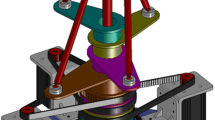Abstract
Robotic manipulators have been conventionally used for position-controlled tasks such as pick-and-place, spray painting and arc welding, where the tools do not experience contact forces from external objects. In recent years, however, there is an increasing interest in using robotic manipulators to perform machining work, for e.g. drilling, polishing, deburring and milling. This is due to the greater dexterity of robots as compared to that of CNC machines (6 axes vs. 3 or 5 axes), as well as the lower cost of industrial manipulators. Nevertheless, in such machining applications, the object exerts external forces onto the tools and thus onto the robots, and robots would generally deflect because of their low joint and link stiffness. This deflection prevents the tools from cutting, drilling or milling the objects into the correct depth, and therefore the dimension of the machined object would not be accurate. In this paper, a novel design of robotic manipulator is proposed, which combines the advantages of both parallel and serial robots, and is suitable for machining applications. The manipulator acts as a stiff parallel manipulator when carrying out machining tasks, but transforms into a serial articulated manipulator when maneuvering through a large area. Experimental results show that the proposed manipulator has a higher stiffness than a serial manipulator of the same size, and that it outperforms conventional serial robots in carrying out machining work.
Similar content being viewed by others
References
Carnegie Mellon University (2003) Robot hall of fame—unimate. http://www.robothalloffame.org/inductees/03inductees/unimate.html. Accessed 15 June 2017
Pan Z, Zhang H, Wang J (2006) Chatter analysis of robotic machining process. J Mater Process Technol 173:301–309
Chen Y, Dong F (2013) Robot machining: recent development and future research issues. Int J Adv Manuf Technol 66:1489–1497
Ang MH, Wang W, Loh RNK, Low TS (1997) Passive compliance from robot limbs and its usefulness in robotic automation. J Intell Robot Syst 20:1–21
Sun YC, Lai CY (2014) Robotic finishing. In: Nee A Y C (ed) Handbook manufacturing engineering and technology. Springer, London, pp 2445–2468
Lai CY (2014) Improving transient performance in robotics force control using nonlinear damping. In: Proceedings of the IEEE/ASME international conference advanced intelligent mechatronics. Besancon
International Federation of Robotics (2013) https://www.robotics.org. Accessed: 18 Feb 2012
Schreck G, Surdilovic D, Krueger J (2014) HEPHESTOS: hard material small-batch industrial machining robot. In: Proceedings of the 45th international symposium on robotics (ISR 2014) and 8th German conference on robotics (ROBOTIK) . Munich
Matsuoka SI, Shimizu K, Yamazaji N, Oki Y (1999) High-speed end milling of an articulated robot and its characteristics. J Mater Process Technol 95:83–89
Chablat D, Wenger P (2003) Architecture optimization of a 3-DOF translational mechanism for machining applications, the Orthoglide. IEEE Trans Robot Autom 19(3):403–410
Lee MK (1997) Design of a high stiffness machining robot arm using double parallel mechanisms. In: Proceedings of the IEEE international conference on robotics and automation. Nagoya
Huang YM, Dong LX, Wang XU, Gao F, Liu YC, Minami M, Asakura T (1997) Development of a new type of machining robot—a new type of driving mechanism. In: Proceedings of the IEEE international conference on intelligent processing systems. Beijing
Oiwa T (2005) Error compensation system for joints, links and machine frame of parallel kinematics machines. Int J Robot Res 24(12):1087–1102
Wang J, Zhang H, Fuhlbrigge T (2009) Improving machining accuracy with robot deformation compensation. In: Proceedings of the IEEE/RSJ international conference on intelligent robots and systems. St. Louis
Abele E, Weigold M, Kulook M (2006) Increasing the accuracy of milling industrial robot. Prod Eng 13(2):221–224
DeVlieg R, Sitton K, Feikert E, Inmam J (2002). ONCE (One-sided Cell End-Effector) robotic drilling system. Society of Automotive Engineers
Zargarbashi SHH, Khan W, Angeles J (2012) Posture optimization in robot-assisted machining operations. Mech Mach Theory 51:74–86
Sharon A, Hardt DE (1984) Enhancement of robot accuracy using endpoint feedback and a macro-micro manipulator system. In: Proceedings of the American control conference. San Diego
Khatib O (1990) Reduced effective inertia in macro/mini manipulator system. In: Proceedings of the 5th international symposium on robotics research
Lai CY (2014) Decoupling of macro-mini manipulator using adaptive neural networks. In: Proceedings of the IEEE/ASME international conference on advanced intelligent mechatronics, Besancon
Mohammad AEK, Hong J, Wang D (2018) Design of a force-controlled end-effector with low-inertia effect for robotic polishing using macro-mini robot approach. Robot Comput Integr Manuf 49:54–65
Burgard W, Moors M, Fox D, Simmons R, Thrun S (2000) Collaborative multi-robot exploration. In: Proceedings of the IEEE international conference on robotics and automation. San Francisco
Fregene K, Madhavan R, Kennedy D (2004) Coordinated control of multiple terrain mapping UGVs. In: Proceedings of the IEEE international conference on robotics. New Orleans
Kim J, Bonadies S, Lee A, Gadsden SA (2017) A cooperative exploration strategy with efficient backtracking for mobile robots. In: Proceedings of the IEEE international symposium robotics and intelligent sensors. Ottawa
Kohlmaier M (2015) ABB robotics—trends and innovations. In: Forum robotics
Craig JJ (1989) Introduction to robotics—mechanics and control, 2nd edn. Prentice Hall, Englewood Cliffs
Chen SF, Kao I (2000) Conservative congruence transformation for joint and Cartesian stiffness matrices of robotic hands and fingers. Int J Robot Res 19(9):835–847
Polulu (2017) Power HD High-Torque Servo 1501MG. https://www.pololu.com/product/1057. Accessed 24 June 2017
Author information
Authors and Affiliations
Corresponding author
Additional information
Publisher’s Note
Springer Nature remains neutral with regard to jurisdictional claims in published maps and institutional affiliations.
Rights and permissions
About this article
Cite this article
Lai, C.Y., Villacis Chavez, D.E. & Ding, S. Transformable parallel-serial manipulator for robotic machining. Int J Adv Manuf Technol 97, 2987–2996 (2018). https://doi.org/10.1007/s00170-018-2170-z
Received:
Accepted:
Published:
Issue Date:
DOI: https://doi.org/10.1007/s00170-018-2170-z




